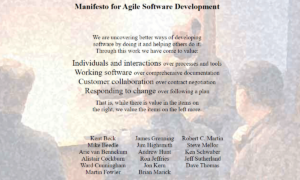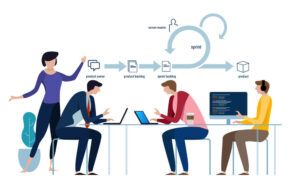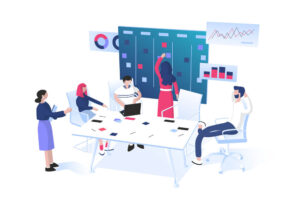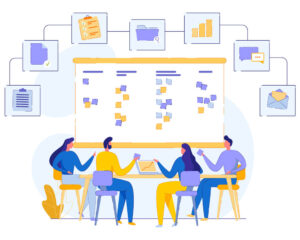Key Takeaways: Agile Estimation
- There are estimation techniques that are suitable for inexperienced teams, like story points, and experienced Agile teams, such as the bucket system.
- Estimating user stories and tasks before a sprint starts can help teams stay focused, on track and on budget.
- Estimation meetings are highly collaborative and require open communication during the meeting.
Estimating how long tasks will take to complete is one of the most important planning rituals of any Agile project. However, it’s also one of the most challenging. If you don’t want to fall prey to scope creep, customer-set deadlines and more, you and your team must be comfortable estimating tasks via numerous Agile estimation techniques.
In this guide, we’ll teach you all about Agile estimation, how it can greatly improve the outcomes of your projects and what Agile estimation challenges you may face. We’ll also share 10 of the best Agile estimation techniques with you so that you can pick the right one for your upcoming project. Without further ado, let’s see what Agile estimation can do for you.
What Is Agile Estimation?
In a nutshell, Agile estimation is when Agile teams estimate how much effort or time it will take to complete a task for a project. In Scrum, estimation efforts occur during sprint planning meetings. The end result should be a well-planned sprint with tasks that teams and individuals should be able to complete easily within the next time-boxed sprint.

effort will be required for project tasks.
Below, we’ll further break down what Agile estimation is so that you can get a better understanding of what goes into this important part of project planning.
Principles of Agile Estimation
It’s important to know that Agile estimation, like Agile itself, is built around principles that must be followed if teams want to get the most out of the process. Here’s a list of the most common principles that should be followed.
- When estimating, teams should shoot for accuracy not precision. It’s simply impossible to be precise, as Agile tasks constantly evolve.
- Estimations should be based on relative units, like those found in the t-shirt size estimation method (S, M, L, XL, XXL), a Fibonacci sequence, or the planning poker method. We’ll cover all of these and more later.
- Always remember that an estimation is a best guess.
- Estimations should be made by every team member working on the project.
- If your team has a history of working on projects, data from those projects should be used to help guide effort and time estimations.

guiding principles that must be followed.
Why Run Agile Estimation?
There are many reasons scrum masters or project managers of Agile teams should make estimating part of their planning process. Estimation techniques can help build accountability and discipline, lower risks and improve productivity. On top of this, task estimations can help teams give better timelines to stakeholders and clients.
Who Is Involved in the Agile Estimation Process?
Agile estimation is a whole-team event and should not be put only on the shoulders of a scrum master, a product owner or a project manager. By involving the entire team, over- and under-estimation can be eliminated, and everyone on the team can be prepared for the amount of effort needed should a task be assigned to them.
Stages of Agile Estimation
As a general rule of thumb, Agile estimations are completed in three stages. We’ll briefly cover each of the stages below.
1. Project Initiation Level
Estimations made at the project initiation level are considered high level. Estimates here take into account the total number of requirements in a product backlog task. Each function or requirement of the software that must be developed is assigned a functional point.

At this stage, teams often use quick function point analysis (QFPA) due to there only being high-level requirements. At the end of this process, teams should be able to determine roughly how many hours will be needed to complete all the tasks.
2. Release Level
During this phase of estimating, story points are assigned to user stories. As story points are set, the product owner and the development team prioritize user stories (software functions) and determine which user story should be worked on first, second and so on during the upcoming sprint.
3. Sprint Level
During sprint-level estimations, the team collaborates to split user stories into tasks. From here, the team assigns hours (or whatever numerical value has been agreed upon) based on the complexity of each task. At this point, the task is then assigned to the best team member for that job.

Successful story point estimation at each of these levels is essential. If estimates at the project, release or sprint level are missed, the entire project could blow past deadlines and exceed set budgets. In turn, this would lead to decreased team morale, infighting and many other Scrum anti-patterns.
Agile Estimation Challenges
Agile estimation sounds easy, but it has its challenges. Picking which estimation method to use can be tricky, and if you have a new team with no prior experience, you may find your team over or underestimating tasks. You may also run into a problem where estimates are taken as gospel and are not updated when new information about the project comes to light.
The biggest challenge many teams face is taking a top-down rather than bottom-up approach. In traditional project management methodologies, project managers and their teams have a mutual understanding of the project goal, the budget and the timeline and then brainstorm ways to get to the deliverable.

The top-down method used by many Agile teams is for those who don’t have all of the required information about an upcoming project. Teams know the end goal and how to reach it, but they don’t have enough information to define accurate project durations and costs. Because of that, jobs are broken into smaller tasks and subtasks, and estimates for those tasks are generated.
Challenges with Agile estimation can be avoided by picking the right technique for your project. In the next section, we’ll go over the 10 best Agile estimation techniques so that you can see which one might work best for you and your team.
Overview: The Best Agile Estimation Techniques
Below, you’ll find 10 of the best estimation techniques that can be used as a project backlog management tool. We have chosen techniques that champion communication and collaboration, and that suit new and experienced teams. Check out our recommendations below.
- Planning Poker – A gross-level estimation technique that’s ideal for all teams.
- Three-Point Method – One of the most accurate Agile estimation techniques.
- Dot Voting – Ideal for small teams working on small projects.
- T-Shirt Sizing – An incredibly popular estimation technique due to its simplicity.
- Big, Small, Uncertain – An efficient method for categorizing user stories.
- Bucket System – Complex version of big, small, uncertain that uses Fibonacci sequences.
- Story Counting – For advanced teams with historical sprint data.
- Ordering Protocol/Random Distribution – A turn-based system used to organize tasks.
- Affinity Mapping – A simple task grouping technique that works well with large projects.
- Story Points – One of the most popular methods that’s easy to implement with new and experienced teams.
Now that we have seen the best Agile estimation techniques, we’ll cover them in more detail so that you can see which are suitable for your Agile projects.
10 Best Agile Estimation Techniques
Below, we’ll get into the meat and potatoes of the above-listed Agile estimation techniques. It’s worth noting that the list is not in order from best to worst. Only you can decide which is the most suitable Agile estimation technique for your team. We have simply listed the 10 best methods to try. Let’s dive right in.
Planning Poker

Pros:
- Simple to use
- Encourages group discussion
- Enhances transparency
Cons:
- Not suitable for large groups
- Can take time to agree upon estimates
Planning poker is a gross-level estimation technique that uses playing cards with values between zero and 100. During sprint planning, the product owner covers user stories and features. The team asks questions about each task to get a better understanding of the job. They then vote with the numbered cards. The higher the number, the harder the task is thought to be.
The most common card drawn is what’s used to give the task an estimate. If there are big discrepancies, the team discusses the user story until they agree on an estimate. This method is suitable for small teams as the estimation and following discussions can often be lengthy. This is a wonderful technique for teams who value transparency and collaboration.
Three-Point Method

produce time and effort estimations.
Pros:
- Good for new & veteran teams
- Assigns values & calculate averages
- One of the most accurate methods
Cons:
- Every task must be discussed in great detail upfront
- Agreeing on three values for each user story can take time
The three-point method considers the best, worst and most likely scenarios for a user story to produce an estimate of how much time or effort is required to complete a task. The team is asked how long a task will take if everything goes well (O = Optimal), how long if they run into issues (P = Pessimistic) and what’s most likely taking everything into account (M = Most Likely).
Once values have been assigned to each scenario, you use a simple equation of O+P+M/3 to get an estimation. For example, if you assign two hours to O, eight hours to P and four hours to M, and you add them together and divide by the number of variables (14/3), you’ll get an answer of 4.6 hours.
The three-point method is easy to use, is ideal for new teams and provides accurate estimates. The biggest downside is the time it can take to come to a consensus on values, as each task will need to be talked about in great detail before any values can be assigned.
Dot Voting

The more dots, the more complex the task.
Pros:
- Simple & effective
- Quick Estimates
- Ideal for small teams
- Ideal for small backlogs
Cons:
- Not suitable for new teams
- Requires team members with strong knowledge of tasks
Perhaps the simplest Agile estimation technique listed, dot voting, is ideal for small teams who don’t have an extensive product backlog. During the sprint planning meeting, all the user stories are written on sticky notes and are then placed on a board. The team then marks each task with a dot. The more dots on the sticky note, the more effort is required for that task.
This method is perfect for well-established teams who have worked together previously and have a solid grasp on tasks and the effort required to complete them. If you have a new team with no previous work data or team members with limited experience, this is a method to skip.
T-Shirt Sizing
Pros:
- Great for new teams
- Incredibly simple
- Suitable for projects with large product backlogs
Cons:
- No numerical values lead to less accurate estimates
The t-shirt sizing estimation technique is a favorite of Agile teams due to its simplicity. When using this method, teams select a size from XS (extra small) to XXL (extra-extra large) to describe the effort needed to complete a task. Any decisions made regarding the sizing can be openly discussed between the team, and adjustments can be made if needed.
This technique is ideal for new teams and projects with large product backlogs. The method generates good rough estimates, but can be less accurate as there are no numerical values.
Big, Small, Uncertain
Pros:
- A rapid way to organize tasks
- Ideal new estimation teams
- Works with large backlogs
Cons:
- Not a very accurate method
- Not suitable for large or multiple teams
The “big, small, uncertain” estimation technique is a simplified version of the bucket system (which we’ll cover next). Teams using this estimation technique simply assign big, small or uncertain tags to each item in the product backlog. Items deemed small are quickly set aside, while bigger tasks are marked for more in-depth discussion and estimation later.
The main goal is to identify uncertain tasks. These can show where a team may lack experience or the skills needed to estimate the task’s size. Once the uncertain items have been identified, they can then be dispersed into large or small categories.
The big, small, uncertain technique is rapid and allows small teams to tag many tasks and user stories quickly. This method works well with small teams, but its results are not the most accurate. If you have a large backlog to estimate, this method will work well for you.
Bucket System
Pros:
- Suitable for complex tasks
- Ideal for experienced teams
- Easy-to-understand workflow
Cons:
- Inexperienced team members can struggle
- In-depth discussions to reach a consensus
The bucket system technique is the bigger brother of the “big, small, uncertain” workflow discussed above. The main difference is that the previous system uses sizes to define the complexity of a task, whereas this system uses a Fibonacci number sequence to label user stories. Each number represents a bucket with varying levels of difficulty.
The team comes together and picks a user story from the backlog. Next, the group places the task in one of the buckets based on the team’s knowledge of the task. Simple jobs should be placed in low-numbered buckets, while complex tasks should be placed in high-numbered buckets. This is done until the team accounts for every item in the product backlog.
The bucket system estimation technique is ideal for experienced teams with a good idea of how much work will go into user stories. This method is also fast, which makes it a good fit for teams working on large, complex projects. However, inexperienced team members may struggle to determine accurate values.
Story Counting

have access to previous sprint performance data.
Pros:
- Advanced teams can estimate work quickly
- Ideal for complex projects
Cons:
- Not for inexperienced teams
- Requires fine-tuning throughout the sprint
One of the more advanced estimation techniques teams can use is story counting. To use this method, the team you’re managing must have a history of working together, and there must be historical data from previous projects available. The reason is that in order to estimate how many jobs a team can do during a sprint, previous project averages must be calculated.
Story counting assumes that small and large tasks average out over a set period. This makes it possible to estimate the number of stories a team can complete. You must calculate a team’s velocity by counting how many stories were completed in previous sprints. That number is then used to estimate how many stories might be completed during the next time-boxed event.
Before the sprint starts, management must take into account new team members and team size. Then, during the sprint, leadership must track task progression and make any changes needed. This estimation technique is only for advanced teams who have a thorough knowledge of the tasks at hand.
Ordering Protocol / Random Distribution

Pros:
- Highly collaborative
- Easy to use
- Ideal for all teams
Cons:
- Accuracy concerns
- Process can be long-winded
The ordering protocol, or random distribution technique, sees individuals taking turns picking random user stories from an unorganized list. Every member of the team can then choose an action. They can choose to move an item up or down the list based on its complexity, discuss an item to better understand it or they can skip their go.
The process continues until every individual skips their turn. Once this happens, it means an agreement has been reached about the order of the user stories. This estimation technique promotes team collaboration, but can take some time to conclude. As numerical values aren’t used, the ordering protocol might not be the most accurate technique either.
Affinity Mapping

in a large product backlog.
Pros:
- Ideal for large workloads
- Encourages communication & transparency
- Provides quick estimations
Cons:
- Can require time to fine-tune
- Not suitable for small projects
Affinity mapping, which is also known as affinity grouping, is the process of taking user stories from a large product backlog and grouping tasks with identical complexity or required effort together before breaking the tasks down further.
The product owner will read a user story. Based on the description, the team gives the task a value between one and 10, with 10 being the most difficult. The group then goes through all items in the backlog and groups like items together. Easy tasks are set aside, while more complex tasks are discussed in more detail, so a better estimation can be agreed upon.
Affinity grouping is ideal for teams who are facing a large number of user stories, as it allows them to estimate and group many items together quickly. The simplicity of the technique means it’s ideal for new teams. Still, more experienced teams will be able to better group tasks together based on previous experience.
Story Point Estimation

software platforms and is easy to use.
Pros:
- Simple & effective
- For small & large backlogs
- Built into many software platforms
Cons:
- Can create inconsistencies
Perhaps the most well-known estimation technique is story points. You’ll find this method built into some of the best project management software platforms, like Jira (here’s our Jira review). The idea is simple. Teams allocate a number (usually between zero and 20) to every task that represents how much effort will be needed to complete a job or how complex a task is.
Once each task has been assigned a value, a product owner can quickly organize the backlog, with the most difficult tasks being made a priority. Many teams also assign hours to story points. For example, three points could mean a task will take three to five hours. These values will need to be decided upon by the team.
The method requires internal dialogue between team members. Be aware that inconsistencies stemming from perceived task complexity can arise, especially from inexperienced team members. Still, the story point technique is straightforward and can be used by new and experienced teams.
How to Successfully Run Agile Estimations
It’s all well and good knowing about Agile estimation techniques, but what do you need to do to get a team to buy into the process? Below, we’ll quickly cover a few topics that will help you run successful estimation sessions.
Communicate Openly and Build Trust
As a scrum master or project manager, use your team-building skills during daily stand-ups and retrospective meetings to build team confidence, open lines of communication and let everyone know they’re in a safe space. You’ll find that during sprint meetings, individuals will be comfortable speaking up when it’s their turn to share an opinion.
Involve Everyone
Estimation meetings are not just for key stakeholders. Every member of the Agile team needs to be present so that they can be heard. Every developer, the product owner, the scrum master and even clients can be involved in meetings. Do everything possible to include everyone.
Use Previous Sprint Data
Individuals in Agile teams know what goes into creating features. This means they can likely estimate task workloads accurately. However, to ensure the team is on the right track, analyze your team’s historical data to make sure there are no over or underestimates for an upcoming sprint. Analyzing historical data will help you determine your team’s actual velocity.
Pick the Right Estimation Technique for Your Team
As you’ve learned from the estimation technique descriptions above, each method is not suitable for every team. Before rushing into a decision, analyze your team. Is your team new or experienced? Does the team have any historical data? How big is your team, and do team members communicate freely?
Once you have analyzed your team, you can pick the most suitable method. If you choose an Agile estimation technique that’s too advanced or simple, you may not get total buy-in or accurate estimations.
Final Thoughts: Estimation for Agile Projects
As we all know, planning a project from top to bottom is essential if we want everything to go well. Agile estimating can help teams formulate plans to stay on track, keep focused, remain on budget and hit client-imposed deadlines when using Agile tools. Use the methods mentioned above during sprint planning meetings to collaborate, team-build and set yourself up for success.
Have you used any of the Agile estimation techniques listed above? What are your success stories? Have we missed any techniques that have helped you in the past? Let us know in the comments, and as always, thanks for reading.
FAQ: Agile Estimation
-
Agile estimation techniques are methods teams can use to determine how much effort or time will be needed to successfully complete user stories or tasks.
-
There are many estimation techniques, and they all use different methods to help teams determine the complexity of a task. Some of the most popular techniques include t-shirt sizes, planning poker, story points and the bucket system.
-
The story point estimation technique is one of the simplest yet most effective ways to estimate workloads. Teams assign a numerical value, usually between zero and 20, to tasks. The higher the number, the more complex or involved the task is.
{“@context”:”https:\/\/schema.org”,”@type”:”FAQPage”,”mainEntity”:[{“@type”:”Question”,”name”:”What Are Agile Estimation Techniques?”,”acceptedAnswer”:{“@type”:”Answer”,”text”:”
Agile estimation techniques are methods teams can use to determine how much effort or time will be needed to successfully complete user stories or tasks.\n”}},{“@type”:”Question”,”name”:”What Are Different Estimation Techniques?”,”acceptedAnswer”:{“@type”:”Answer”,”text”:”
There are many estimation techniques, and they all use different methods to help teams determine the complexity of a task. Some of the most popular techniques include t-shirt sizes, planning poker, story points and the bucket system.\n”}},{“@type”:”Question”,”name”:”What Is the Story Point Estimation Technique in Agile?”,”acceptedAnswer”:{“@type”:”Answer”,”text”:”
The story point estimation technique is one of the simplest yet most effective ways to estimate workloads. Teams assign a numerical value, usually between zero and 20, to tasks. The higher the number, the more complex or involved the task is.\n”}}]}
The post 10 Best Agile Estimation Techniques in 2023: How to Successfully Run Estimations appeared first on Cloudwards.

